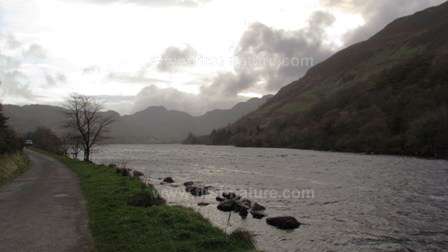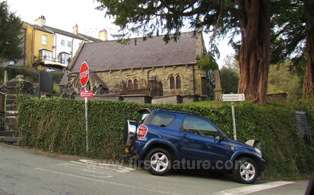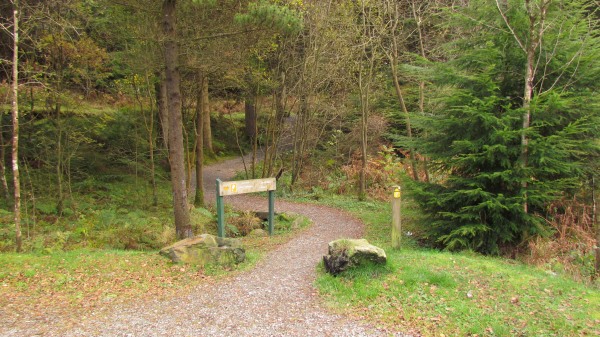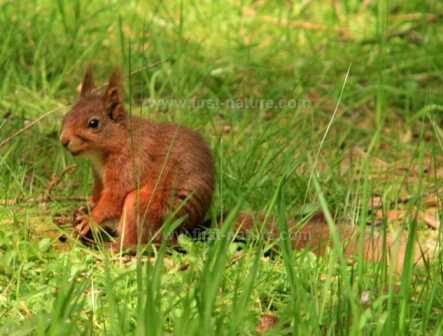Trees Birds Mammals Fish Amphibians Reptiles
Wild Algarve
Bookshop
Cwm Glas Crafnant National Nature Reserve, and Llyn Crafnant Forestry Commission Site, Near Betws y Coed, North Wales
Designations: part of the Cwm Crafnant SSSI
Below: The dramatic scene from Llyn Crafnant on a stormy day

Cwm Glas Crafnant, at the top of a steep and narrow valley, is adjacent to Llyn (Lake) Crafnant, which lies in the basin (Cwm) at the top of the valley. The view from Llyn Crafnant looking towards Snowdonia is wonderful, being dominated by the mountainous landscape of Crimpiau and Creigiau Gleision.
On your way up to the Reserve you will follow the course of the pretty River Crafnant as it flows swiftly down the steep valley from the lake above.
The NNR is a mixture of woodland and open upland grasslands supporting many interesting plants and wildlife species.
The NNR is managed by Natural Resources Wales (NRW) which incorporates former Countryside Council for Wales and Forestry Commission Wales.
Directions
Grid Ref: SH734598
The only car parking available for visitors to the NNR is at the Forestry Commission's site at the northern (narrower) end of Llyn Crafnant.
Take the main A5 road through Betws y Coed in the direction of Bangor and, before leaving Betws y Coed, look out for a small turning on the right-hand side onto the B5106 signed to Trefriw.
Below: Turn left for Llyn Crafnant at Trefriw

Follow this road into Trefriw and then turn left into a narrow lane opposite the Fairy Falls Inn - this lane is signed towards Llyn Crafnant. Continue up this lane, following signs to the lake, until you reach the Forestry Commission Car Park at the top of the valley. There is a small charge for parking at this site.
Facilities
There are no facilities at the NNR, but there are public toilets beside the Forestry Commission Car Park and there is a café beside the lake. There are also shops, pubs and cafés in the village of Trefriw.
Access
Around the lake there is a mostly level and easy track (in part a tarmac road) owned and managed by the Forestry Commission. Part of the track around the lake is suitable for wheelchair users or for prams and pushchairs.
Below: One of the easy-going tracks leading to Llyn Crafnant

The NNR lies at the far (southern) end of the lake, where there is open access to both the woodland and the grassland. The Forestry Commission track passes within 500 metres of the NNR, and this is the best way to gain access. There is a boggy area between the track and the NNR and so good, stout, waterproof footwear is essential.
Description of Site
Most visitors to this area focus on the very attractive Forestry Commission circular walk around Llyn Crafnant. The scenery is outstanding and there are plenty of interesting birds in the woodland. Resident birds include the Blue Tit, Long-tailed Tit, Goldcrest and Siskin. Along the river you may even be lucky enough to get a glimpse of a Dipper or a Grey Wagtail.
The woodland in Cwm Glas Crafnant is largely upland ashwood but includes some upland oakwood, too, along with Hazel, Hawthorn and Wych Elm. In spring the woodland has fine displays of Primroses and other early-flowering plants.
The upland grassland has been damaged by inappropriate grazing, and so part of it is now (2011) fenced off to prevent further damage by livestock and to protect such plants as Hairy Rock-cress (Arabis hirsuta), Green Spleenwort (Asplenium trichomanes-ramosum) and Mountain Sorrel (Oxyria digyna). The rocky outcrops and ledges are important refuges for plants, because they cannot be reached by grazing animals; it is here that Rock Stonecrop (Sedum rupestre) still flourishes.
Below: Red Squirrels were once recorded from Cwm Glas Crafnant

Llyn Crafnant is also an important refuge for some other interesting plantlife: Quillworts and green algae. Spring Quillwort, which has been recorded at Llyn Crafnant, is classed as being Nationally Scarce in Britain. Quillworts are aquatic plants that are thought to be restricted to sub-alpine lakes that are low in nutrients although, confusingly, they have been recorded in lakes with higher levels of nutrients, too. This suggests that their success may be determined by lack of competition from other plants in the same habitats rather than solely by the chemical content of the lakewater in which they grow.
Two groups of green algae (Desmidiales - known as Desmid flora -and Zygnemales) are generally well represented throughout Snowdonia. Although seldom noticed by the casual visitor to the area, Desmids are well known to specialists in the field who are fascinated by their appearance when seen through a microscope. Their cells are beautifully symmetrical and ornamental in appearance. Two such specialists were William and George West, who were exploring Snowdonia in the early 1900s and who concluded that the lakes in the area of Capel Curig and Cwm Crafnant were possibly the finest in the world in which to study these primitve plants.
The peaceful upland area of Cwm Glas Crafnant once had recorded sightings of Red Squirrels and Pine Martens, although they have not been reported from the reserve for many years. The reserve is also home to rare moth species and some interesting spiders, one of which, Clubiona norvegica, is better known from Scandinavia - Denmark and Norway in particular.